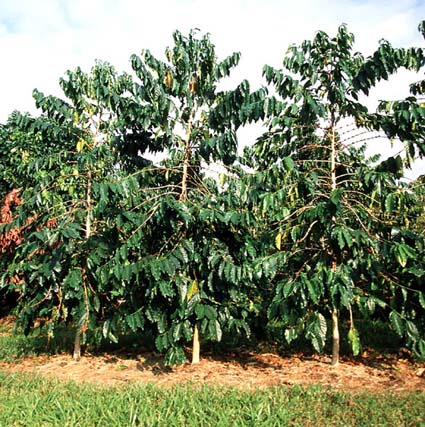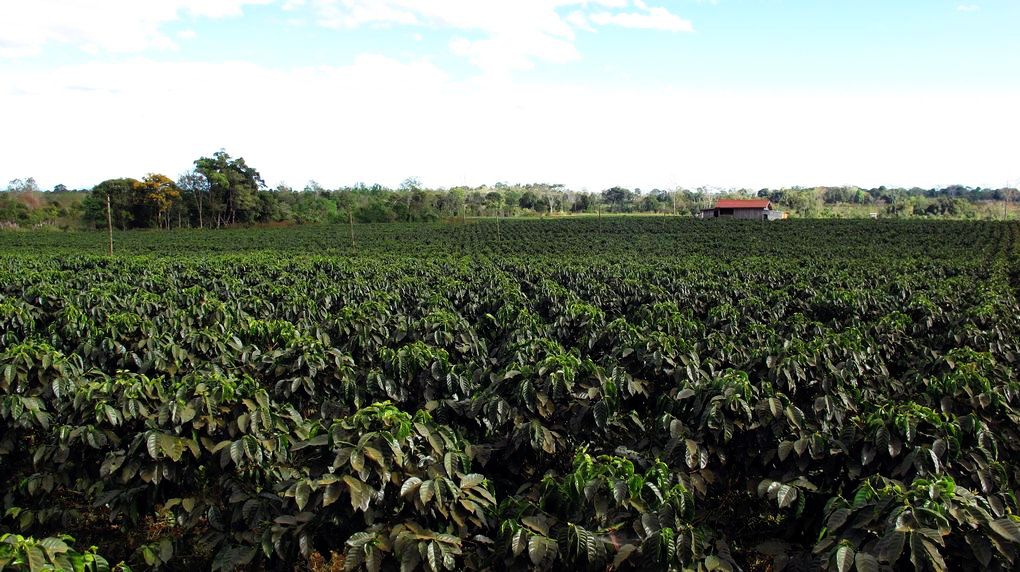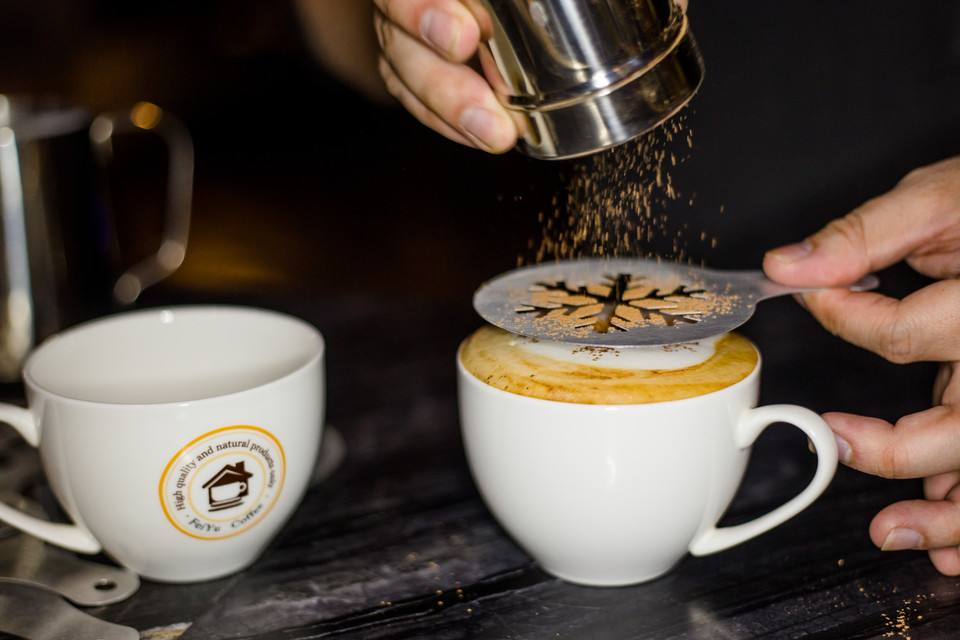Coffee theory study: coffee plant classification, cultivation and processing
Follow the caf é (Wechat official account vdailycom) and found that Beautiful Cafe opened a small shop of its own.
Many people are familiar with coffee powder, but coffee powder is formed after coffee beans are ground. The coffee beans that the average customer gets are fried (roasted) coffee beans, while the unroasted coffee beans are raw coffee beans. If you take a closer look, the raw coffee beans come from the coffee fruits on the coffee trees, that is, the seeds of the coffee trees. So if you want to understand coffee beans, you must first understand coffee trees.
In general, coffee trees can grow to 4-5 meters high, and even 9-10 meters high.

Single coffee tree

Coffee grove
But in places where coffee is grown artificially, people cut off the branches at the top when the coffee tree grows to three meters high, so that the coffee tree does not grow too high, so that it can be picked during harvest.
According to botanical classification, coffee trees belong to
Domain: eukaryotic biomass domain, Eukaryote
Realm: plant kingdom, Plantae
Phylum: angiosperm phylum, Magnoliophyta
Class: dicotyledonous class (Magnolia), Magnoliopsida
Item: gentian, Gentianales
Family: Rubiaceae, Rubiaceae
Genus: coffee, Coffea
1. Types of coffee trees
In order to better understand coffee, coffee trees are divided into the following different species in the genus Coffee.
Arabica grows coffee trees, Coffea Arabica
Canifra grows coffee trees, Coffea Canephora
Grow coffee trees in Liberia, Coffea Liberica
Exelsa grows coffee trees, Coffea Excelsa
De Viri grows coffee trees, Coffea Dewevrei
Cassana grows coffee trees, Coffea Khasiana
Arnoldiana grows coffee trees, Coffea Arnoldiana
Abiokuta grows coffee trees, Coffea Abeokutae
Vitiana grows coffee trees, Coffea Wightiana
Ben Galansis grows coffee trees, Coffea Bengalensis
Travenko Renses grows coffee trees, Coffea Travencorensis
Rismosa planted coffee trees, Coffea Racemosa
Saladrix grows coffee trees, Coffea Salvatrix
Conkinsses grows coffee trees, Coffea Congensis
Capaca grows coffee trees, Coffea Kapakata
Sdinofera grows coffee trees, Coffea Stenophylla
Okini Oydes grows coffee trees, Coffea Eugenioides
Zankuibalia planted coffee tree, Coffea Zanguebariae
Among the above kinds of coffee trees, the first two are mainly used to make coffee drinks.
Arabica coffee, formerly known as "small seed coffee", originated from Ethiopia
Is the most widely cultivated and used to make coffee beverages, accounting for more than 70% of the world's total.
Canifra grows coffee, formerly known as "medium seed coffee", originally from the Congo.
Slightly less than 30% of the world's total output
The third category is
Liberica grows coffee, formerly known as "large seed coffee", originally from Liberia.
Although the selling price of this kind of coffee is very low, because of its poor taste, few people buy it and use it to make coffee drinks. Now it is rarely planted in places such as Malaysia, and it is usually rarely seen on the market and almost impossible to buy.
Other types of coffee trees have not yet been used to make coffee drinks from their beans, but most of them exist in the Ethiopian rainforest and are protected by the Ethiopian government. Maybe one day we will get better coffee beans from these coffee trees that have not yet been used to make coffee drinks!
(a) two kinds of practical coffee
Since other coffee trees are not used to make coffee drinks, we don't have to talk too much about them. What we are most concerned about is the two kinds of coffee that are mainly used to make coffee drinks.
Arabica grows coffee beans, and Arabica grows coffee trees.
Robbas special coffee beans, grown in Canifa.
These two kinds of coffee trees are suitable for planting in different areas, the coffee beans have different taste characteristics, need to use different processing methods, and can be used to make different coffee drinks. If you don't understand the characteristics of these different kinds of coffee, you don't know how to properly use and process these coffee beans to make a good coffee drink.
The reason why we first emphasize these two different kinds of coffee is that there are many very different aspects of these two kinds of coffee, so it is one of the basic concepts for us to understand coffee. Paying attention to the distinction between these two different types of coffee is the basis and key to understanding coffee.
(B) different growth environments
The suitable environmental conditions for the growth of coffee trees in Arabica are that the annual temperature varies from 15 to 25, the annual rainfall is between 1500 and 2000 mm, and it should be in line with the flowering period of coffee trees. In addition, the growth of coffee trees also has high requirements for the soil. If the soil is not fertile enough and the nutrients, including a variety of trace elements, are not enough, it may affect the growth of coffee trees and the formation of flavor components of coffee beans. Therefore, the soil environment composed of volcanic ash provides very favorable soil conditions for the growth of coffee trees.
Although the growth of Arabica coffee trees needs sunlight, the strong direct sunlight is disadvantageous to the growth of Arabica coffee trees. The growth of Arabica coffee trees is more suitable for reflecting sunlight through other canopies. Therefore, in areas where coffee is artificially planted, intercropping is generally used. That is, for each row of coffee trees, a row of taller, larger crowns, such as banana trees, should be planted in the middle to shade the coffee trees. However, in Yunnan, where there are few sunny days and mostly rainy days, not interplanting will not be detrimental to the growth of coffee trees, but will also greatly increase the yield of coffee per mu.
The environmental conditions suitable for planting coffee trees in Arabica limit the most suitable areas for planting coffee trees in Arabica are tropical or subtropical alpine areas, generally at an altitude of no less than 800m to 1000m. Because the year-round temperature in the plain is too high, it is not suitable for the growth of coffee trees in Arabica. But the highest is usually no more than 2000 meters, because frost may occur in areas too high above sea level, and coffee trees may freeze to death in the event of frost. So even Arabica coffee trees cannot be planted in areas too high above sea level.
Sometimes we see the so-called "shady coffee" (shading coffee) in the market. These coffees are generally grown and harvested in the "shade" of the mountains. Because there is no or little sunshine on the shady side, the coffee beans harvested on the coffee trees grown here will have better taste characteristics. It is because Arabica coffee trees do not like the sun, so coffee beans grown and harvested in such areas will have a better taste. However, this is only a small part, there is no particularly strong reaction.
In contrast, coffee trees grown in Canifra require higher ambient temperatures, ranging from 24 to 29 degrees throughout the year, and prefer direct sunlight. So growing coffee trees in Canifra is suitable for growing in tropical or subtropical low-altitude areas. Its most important feature is resistance to diseases and insect pests and is not likely to be affected by insect pests. Therefore, the areas where coffee trees are planted in Canifra are tropical or subtropical low-altitude areas.
(C) differences in taste characteristics
There is a big difference in taste between coffee beans grown in Arabica and coffee beans grown in Robastian (grown in Canifa). It even affects that different coffee beans are suitable for processing in different ways and are used to make different coffee drinks. Therefore, it is very important for us to distinguish between these two kinds of coffee beans.
Arabica grows coffee beans:
The taste is delicate and soft, often with different taste characteristics due to variety and origin, such as the taste of different fruits, different nuts, chocolate, and so on.
Robbas special coffee beans:
The taste is strong and rich, sometimes with a fishy, spicy, and other bad taste. Some people can even smell the smelly charred rubber when roasting roast coffee.
Because of the great difference in taste, Arabica coffee has always been considered to be of higher quality than Robaster coffee and is sold at a higher price in the international market. Robbas special coffee is sold at a lower price in the international market because of its poor taste. Of course, this is not absolute. If carefully selected, Robaster coffee can also choose a lot of very good coffee, and the price is not lower than that of ordinary Arabica coffee. This has left such a deep impression on people for a long time that up to now many people still cannot accept the use of Robaster coffee to make coffee drinks. Whether it's drip coffee or espresso.
The above taste is the feeling when making drip filter coffee, but the taste when making espresso is probably different. We will discuss more about growing coffee beans in Robaster later.
2. Varieties of coffee trees
After understanding the different types of coffee, let's take a look, especially the Arabica coffee that people are most concerned about can be divided into many different varieties.
Usually when a farm chooses which kind of coffee to grow, the first consideration is the yield and the ability to resist diseases and insect pests. Then the quality of the coffee will be considered. But now the coffee market is developing faster, and the market also needs better coffee, so if you find a way to grow high-quality coffee, you may sell it at a good price. In particular, some coffee enterprises and individuals (for example, Italian coffee companies in Puerto Rico and Australians in Indonesia) go to coffee growing countries to personally participate in the cultivation and processing of coffee. They will try to improve the quality of coffee by selecting good varieties and better processing equipment and technology.
It is generally believed that bourbon coffee and Tibica coffee are two basic varieties of Arabica coffee. As a result, many varieties have been developed.
The common ones in the market now include the following
Typica, Tibica
This is the most basic variety of Arabica coffee, and many varieties are derived from it. This kind of coffee tree is 3.5-4 meters high and the yield is very low, but the coffee tastes very good.
Bourbon, bourbon
The output of bourbon coffee is 20-30% higher than that of Tiebika coffee, but lower than that of other kinds of coffee. This kind of coffee tree has wide leaves and curved surroundings. The fruit of this kind of coffee tree is relatively small and hard. Fruit falls easily in strong wind or rain. The most suitable growing area is 1200-2200 meters above sea level. The coffee tastes excellent, similar to Tibica coffee.
Mundo Novo, Mondo Novo
This is the grafted variety of Tibica coffee and bourbon coffee, which was first found in Brazil. The variety is sturdy and resistant to diseases and insect pests, and its yield is high, but its maturity is slightly later than that of other varieties. The altitude suitable for growing areas is 1170-1800 meters, and the rainfall is 1200-1800 mm.
Maragogype, Marago Rippi (commonly known as "elephant bean")
This is a variant of bourbon coffee, first found in Brazil. The tree is stout and taller than bourbon and Tibica. But the yield is low and the coffee beans are very large. It is suitable to grow in the area of 660-830 meters above sea level. It is very popular in some markets.
Amarello, Amarero
This variety of coffee fruit is yellow and is not widely planted.
Caturra, Kaddura
This is a variant of bourbon coffee found in Brazil. This kind of coffee is of high yield and good quality, but requires careful maintenance and nutrition. Similar to bourbon coffee, this breed of coffee has broad leaves and curved edges. It is suitable for planting in a variety of environments, but it works best in areas with an altitude of 500-1830 meters and an annual rainfall of 2500-3500 mm. If the altitude is higher, the quality will be better, but the output will be reduced.
Catimor, Katimer.
It was grafted with Timor coffee and Kaddura coffee in Portugal in 1959, and the yield is very high, equal to or even higher than all commercial varieties.
Catuai, Kaduai
This is a combination of Mondonovo coffee and Kaddura coffee with a high yield. The fruit of this kind of coffee tree is not easy to fall, so it is suitable for planting in windy and rainy areas. Need more maintenance and nutrition.
Kents, Kent
This variety of coffee is widely cultivated because of its high yield and resistance to coffee leaf rust.
These are mainly different varieties of coffee grown in Arabica, and some are a series of coffee trees grown in Arabica and Canifra. There are many others, not to list one by one.
The concept of "variety" introduced above seems to be very unfamiliar. Why are these names seldom heard of? That is because coffee beans belong to crops and are highly dependent on the soil, climate, maintenance and other conditions of the region. The difference in taste between different varieties is not obvious enough, and it is always affected by the area under cultivation. That is to say, if the same variety of coffee is grown in different regions, the taste of coffee is different. Therefore, a simple distinction between varieties is of no practical significance to understand the taste of coffee. So when talking about a certain kind of coffee, first of all, distinguish between Arabica coffee and Robaster coffee; second, when distinguishing between varieties, be sure to indicate the planting area, otherwise it is impossible to determine its taste.
In fact, the concept of further classification commonly used is the concept of "variety + origin", that is, to determine the "origin" while determining the "variety". In fact, what we see is the concept of "commercial variety", such as "Santos" coffee in Brazil, "Yegashafi" in Ethiopia, "Bugisu" coffee in Uganda, and so on. These coffees are certain varieties, and the producing area is also relatively certain, so they usually have specific taste characteristics.
But some coffee varieties are uncertain, such as Colombian coffee. According to Colombian government regulations, as long as coffee beans are grown and harvested in Colombia, they are called "Colombian coffee". However, I am afraid that the coffee trees planted in Colombia are not a single variety; in addition, the size of the Colombian country is not very small, and the gap between the north and the south and the east and west cannot be completely ignored. therefore, it is difficult to determine the specific taste characteristics of the country's coffee simply by using "Colombian coffee" to classify the country's coffee. So now there are a lot of raw coffee dealers starting to sell "manor coffee", that is, coffee beans from a particular estate in Colombia. The variety of such coffee beans is usually single, and the planting area is very small, so the taste characteristics are more definite. This may be a good starting point for further classification of coffee in the future.
Although the growth cycles of different species and varieties of coffee trees are different, they are usually between 7 and 8 months. In other words, the growth cycle of coffee trees is not as seasonal as in the north, but the growth and harvest is not fixed time. This is mainly because the climate gap in the south is small throughout the year, or there is no obvious seasonality. For example, if you harvest once in January of a year, you will harvest again after 7-8 months. This means that two seasons can be harvested this year. But next year, there will be only one season left.
III. Picking of coffee fruits
The picking of coffee fruits is divided into
Manual picking leads to an increase in the cost of coffee due to the high cost of labor. But manual picking can select coffee fruits that are ripe and suitable. It is generally suitable for coffee that can be sold at a higher price, and will not be unable to earn money because the cost is too high.
The cost of machine picking is not high, but the machine can not tell whether the coffee fruit is ripe or not, so we can only pick all the coffee fruit together, and then remove the overripe and immature coffee fruit. But from the grower's point of view, the selection will not be very strict. So it is inevitable that some coffee fruits that are overripe or not ripe enough will remain. This may affect the quality and taste of processed coffee beans.
IV. Processing of raw coffee beans
The quality of coffee beans depends not only on the planting conditions and the maintenance of coffee trees, but also on the processing of raw coffee beans. Since the coffee fruit has been picked from the tree, the peel and pulp have to be removed to get the coffee beans we need. But the treatment of coffee fruit also plays an important role in the taste of coffee beans.
(1) drying method
The oldest method of treatment is, of course, the solarization method, which is generally called the "drying method". Because coffee fruits are berries with high water content, they become very brittle after drying. Just gently press the dried peel and pulp to crush and detach the coffee beans. The appearance of the coffee beans processed by this method is not standard, and the colors are both light yellow and yellowish brown. Perhaps it is due to the lack of strict selection, different sizes and colors. So it doesn't look very good.
(2) washing method
After many years of development, people have developed a more advanced washing method in order to better process high-quality coffee beans. Although the cost of washing is relatively high, the processed coffee beans look good and sell well.
Important Notice :
前街咖啡 FrontStreet Coffee has moved to new addredd:
FrontStreet Coffee Address: 315,Donghua East Road,GuangZhou
Tel:020 38364473
- Prev

Coffee Learning: the History, legends and stories of Coffee
The early historical records of coffee are almost zero, so those are the stories that modern people know. As for what the facts are, there is no way to know. But we can also make some guesses about those legends, after all, this is almost the only way to know and explore the truth now. We can understand the history of coffee from several aspects.
- Next

Coffee Learning: the Theory and Technology of making Coffee Beverage
First, the classification of coffee beverages if we want to understand coffee drinks, we must first classify coffee drinks properly. In order to better understand these coffee drinks, and their extraction principles and production techniques. First of all, it needs to be explained that some people may have different views or practices on classification. But in principle, the method of classification is only a means, and there is no difference between right and wrong.
Related
- What is the meaning of lactic acid fermentation with coffee bean treatment?
- How to judge the state of foam by sound?
- How does the latte pull out the unicorn pattern? Come to get for a little trick to improve the flower pull!
- Will flower pulling affect the taste of the latte?
- Do you know the history of coffee?
- The difference between honey treatment and sun washing what is raisin honey treatment?
- What kind of milk can a novice use to make coffee foam to keep the foam longer? The correct method and skills of milking tutorial sharing
- Why do washed coffee beans taste sour? Flavor characteristics of washed Coffee
- Introduction to the skill of how to practice the size and height of water injection around the circle of hand-brewed coffee
- How do beginners practice coffee flower drawing from scratch?

